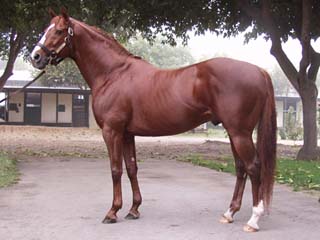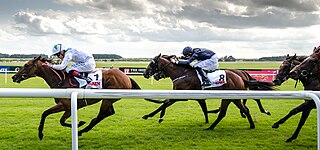
The horse is a domesticated, one-toed, hoofed mammal. It belongs to the taxonomic family Equidae and is one of two extant subspecies of Equus ferus. The horse has evolved over the past 45 to 55 million years from a small multi-toed creature, close to Eohippus, into the large, single-toed animal of today. Humans began domesticating horses around 4000 BCE, and their domestication is believed to have been widespread by 3000 BCE. Horses in the subspecies caballus are domesticated, although some domesticated populations live in the wild as feral horses. These feral populations are not true wild horses, which are horses that never have been domesticated and historically linked to the megafauna category of species. There is an extensive, specialized vocabulary used to describe equine-related concepts, covering everything from anatomy to life stages, size, colors, markings, breeds, locomotion, and behavior.

Thoroughbred racing is a sport and industry involving the racing of Thoroughbred horses. It is governed by different national bodies. There are two forms of the sport – flat racing and jump racing, the latter known as National Hunt racing in the UK and steeplechasing in the US. Jump racing can be further divided into hurdling and steeplechasing.

Equestrianism, commonly known as horse riding or horseback riding, includes the disciplines of riding, driving, and vaulting. This broad description includes the use of horses for practical working purposes, transportation, recreational activities, artistic or cultural exercises, and competitive sport.

A gelding is a castrated male horse or other equine, such as a pony, donkey or a mule. The term is also used with certain other animals and livestock, such as domesticated camels. By comparison, the equivalent term for a castrated male bull would be ox, or a wether for rams and billy goats.

A veterinarian (vet) is a medical professional who practices veterinary medicine. They manage a wide range of health conditions and injuries in non-human animals. Along with this, veterinarians also play a role in animal reproduction, health management, conservation, husbandry and breeding and preventive medicine like nutrition, vaccination and parasitic control as well as biosecurity and zoonotic disease surveillance and prevention.

Classical dressage evolved from cavalry movements and training for the battlefield, and has since developed into the competitive dressage seen today. Classical riding is the art of riding in harmony with, rather than against, the horse.
On Horsemanship is the English title usually given to Περὶ ἱππικῆς, peri hippikēs, one of the two treatises on horsemanship by the Athenian historian and soldier Xenophon. Other common titles for this work are De equis alendis and The Art of Horsemanship. The other work by Xenophon on horsemanship is Ἱππαρχικὸς, hipparchikos, usually known as Hipparchicus, or The cavalry commander. The title De re equestri may refer to either of the two.

Natural horsemanship is a collective term for a variety of horse training techniques which have seen rapid growth in popularity since the 1980s. The techniques vary in their precise tenets but generally share principles of "a kinder and gentler cowboy" to develop a rapport with horses, using methods said to be derived from observation of the natural behavior of free-roaming horses and rejecting abusive training methods.

Horse training refers to a variety of practices that teach horses to perform certain behaviors when commanded to do so by humans. Horses are trained to be manageable by humans for everyday care as well as for equestrian activities, ranging anywhere from equine sports such as horse racing, dressage, or jumping, to therapeutic horseback riding for people with disabilities.

The first evidence of horses in warfare dates from Eurasia between 4000 and 3000 BC. A Sumerian illustration of warfare from 2500 BC depicts some type of equine pulling wagons. By 1600 BC, improved harness and chariot designs made chariot warfare common throughout the Ancient Near East, and the earliest written training manual for war horses was a guide for training chariot horses written about 1350 BC. As formal cavalry tactics replaced the chariot, so did new training methods, and by 360 BC, the Greek cavalry officer Xenophon had written an extensive treatise on horsemanship. The effectiveness of horses in battle was also revolutionized by improvements in technology, such as the invention of the saddle, the stirrup, and the horse collar.
Equine drug testing is a form of drug testing applied to performance horses in regulated competition. Most common in racehorses, drug tests are also performed on horses in endurance riding and in international competition such as the Olympics and FEI-sanctioned competition. Many horses in a competition sanctioned by various national organizations, such as the United States Equestrian Federation in the USA are also tested for improper drug use. An organization for cooperation and harmonization regarding horseracing is the International Federation of Horseracing Authorities (IFHA) that have several members in over 50 countries worldwide.

Equine-assisted therapy (EAT) encompasses a range of treatments that involve activities with horses and other equines to promote human physical and mental health. Modern use of horses for mental health treatment dates to the 1990s. Systematic review of studies of EAT as applied to physical health date only to about 2007, and a lack of common terminology and standardization has caused problems with meta-analysis. Due to a lack of high-quality studies assessing the efficacy of equine-assisted therapies for mental health treatment, concerns have been raised that these therapies should not replace or divert resources from other evidence-based mental health therapies. The existing body of evidence does not justify the promotion and use of equine-related treatments for mental disorders.

A bitless bridle is a general term describing a wide range of headgear for horses or other animals that controls the animal without using a bit. Direction control may also be via a noseband or cavesson, if one is used. The term hackamore is the most historically accurate word for most common forms of bitless headgear. However, some modern bitless designs of horse headgear lack the heavy noseband of a true hackamore and instead use straps that tighten around a horse's head to apply pressure in various ways. These are often specifically patented and marketed as "bitless bridles", usually referencing a particular type of headgear known as the cross-under, though other designs are sometimes also given similar names.

The Thoroughbred is a horse breed developed for horse racing. Although the word thoroughbred is sometimes used to refer to any breed of purebred horse, it technically refers only to the Thoroughbred breed. Thoroughbreds are considered "hot-blooded" horses that are known for their agility, speed, and spirit.

Natural hoof care is the practice of keeping horses so that their hooves are worn down naturally, or trimmed to emulate natural wear, so they do not suffer overgrowth, splitting and other disorders. Horseshoes are not used, but domesticated horses may still require trimming, exercise and other measures to maintain a natural shape and degree of wear.

This is a basic glossary of equestrian terms that includes both technical terminology and jargon developed over the centuries for horses and other equidae, as well as various horse-related concepts. Where noted, some terms are used only in American English (US), only in British English (UK), or are regional to a particular part of the world, such as Australia (AU).
Racehorse injuries and fatalities are a side effect of the training and competition of horse racing. Racehorse injuries are considered especially difficult to treat, as they frequently result in the death of the horse. A 2005 study by the United States Department of Agriculture found that injuries are the second leading cause of death in horses, second only to old age.
Hipparchicus is one of the two treatises on horsemanship by the Athenian historian and soldier Xenophon (circa 430–354 BC). Other common titles for this work include The cavalry commander and The cavalry general. The other work by Xenophon on horsemanship is Περὶ ἱππικῆς, Perì hippikēs, usually translated as On horsemanship, De equis alendis or The Art of Horsemanship. The title De re equestri may refer to either one of the two works. Hipparchicus deals mainly with the duties of the cavalry commander (hipparchus), while On horsemanship deals with the selection, care and training of horses in general.

A hot walker within the practice of horse management is a person such as a groom or stable worker who hand walks hot, sweaty horses after a workout, particularly after work on a racetrack. The term hot walker may also refer to a mechanical device designed for the same purpose.

Horse racing in Ireland is intricately linked with Irish culture and society. The racing of horses has a long history on the island, being mentioned in some of the earliest texts. Domestically, racing is one of Ireland's most popular spectator sports, while on the international scene, Ireland is one of the strongest producers and trainers of Thoroughbred horses. The Irish horse racing industry is closely linked with that of Great Britain, with Irish horses regularly competing and winning on the British racing circuit.
















